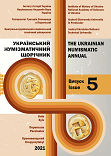REGIONAL BIAS IN LATE ANTIQUE AND EARLY MEDIEVAL COIN FINDS AND ITS EFFECTS ON DATA: THREE CASE STUDIES
REGIONAL BIAS IN LATE ANTIQUE AND EARLY MEDIEVAL COIN FINDS AND ITS EFFECTS ON DATA: THREE CASE STUDIES
Author(s): Mark PyzykSubject(s): Regional Geography, Economic history, Ancient World, 6th to 12th Centuries
Published by: ДВНЗ Переяслав-Хмельницький державний педагогічний університет імені Григорія Сковороди
Keywords: FLAME coin database; Late Antique and Early Medieval Economy; Roman and Byzantine coin finds; numismatic finds topography;
Summary/Abstract: This paper discusses the role of bias and uncertainty in the FLAME project (Framing the Late Antique and Early Medieval Economy) at Princeton University. FLAME is a large Digital Humanities project focused on collecting and storing data on coin minting and circulation in west Afro-Eurasia from 325 to 750 CE, roughly coinciding with the period of transition between the late antique and early medieval periods. The overarching goal is historical - that is, we wish to be able to say something new about how the world of late antiquity and the medieval period really was. However, in the process of building this database, and its accompanying online tools, we have also observed that the data is difficult and problematic. This paper, then, is an account of some of these historiographical and methodological issues in the form of three case studies (Britain, France, and Ukraine) and a short discussion of strategies that FLAME employs to communicate these biases to users, who benefit from a transparent discussion of messiness and difficulty in the data. The paper proceeds in seven sections, of which the first is an introduction. Section Two presents basic technical details of the project, such as its database implementation (MySQL) and its online visualization systems (ArcGIS), access to which can be found at https://flame.princeton.edu. Section Three discusses the historiographic questions at stake, distinguishing between Primary Bias (inherent in materials themselves) and Secondary Bias (particular to national and political contexts). Section Four, Five, and Six are each devoted to a separate case study: Britain, France, and Ukraine. Each discusses FLAME's data on that region and briefly touches upon contextual factors that may bias regional data. Thus, Section Four discusses Britain, with much analysis focused on the role of the Portable Antiquities Scheme in incentivizing reporting of found antiquities, and its effects on coin data. Section Five discusses France, where FLAME records many coin finds, but from a limited time period (primarily from Merovingian states). Section Six discusses the situation in Ukraine, where we were helped by existing scholarly resources (such as the coin inventories of Kropotkin), but where cultural heritage preservation suffers from weak state enforcement and where much scholarship suffers from spotty recording practices, and often outright theft of national treasures, going back to the imperial Russian period. Section Seven concludes the paper, noting that such methodological and second-order discussion of bias is a critical desideratum for the Digital Humanities as it matures into its second decade.
Journal: Український Нумізматичний Щорічник
- Issue Year: 2021
- Issue No: 5
- Page Range: 197-210
- Page Count: 14
- Language: English

